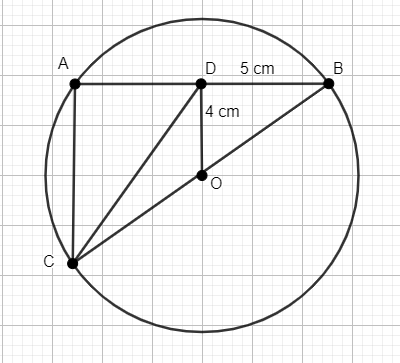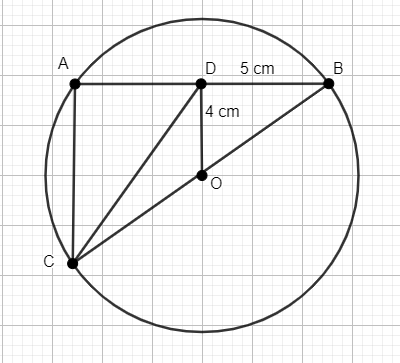
O is the centre of the circle. BC is the diameter of the circle. OD is perpendicular to AB. If OD = 4 cm and BD = 5 cm then find the value of CD.


Answer
522.3k+ views
Hint: To solve the question, we have to apply the Pythagorean theorem to calculate the unknown values of sides of given triangles. To solve further, apply the properties of an angle in semicircle and the properties of perpendicular bisectors for the given diagram to obtain the required values.
Complete step-by-step answer:
We know that by Pythagorean theorem, we get, in a right-angle triangle XYZ

By applying the above theorem for
By substituting the given value in above equation, we get
We know OC = OB since OC, OB are the radius of the given circle. Thus, we get
We know
Given that OB is perpendicular to AB, this implies that D is the mid-point of AB since the perpendicular drawn from the centre of a circle to its any chord always bisects the chord.
Thus, we get BD = AD = 5 cm
We know AB = AD + BD = 5 + 5 = 10 cm
We know the angle in a semicircle is always
By applying the Pythagorean theorem for
By substituting the given value in above equation, we get
By applying the Pythagorean theorem for
By substituting the given value in above equation, we get
Thus, the measurement of CD is equal to
Note: The possibility of mistake can be, not applying the Pythagorean theorem to calculate the unknown values of sides of given triangles. The other possible mistake can be, not applying the properties of an angle in semicircle and the properties of perpendicular bisectors.
Complete step-by-step answer:
We know that by Pythagorean theorem, we get, in a right-angle triangle XYZ

By applying the above theorem for
By substituting the given value in above equation, we get
We know OC = OB since OC, OB are the radius of the given circle. Thus, we get
We know
Given that OB is perpendicular to AB, this implies that D is the mid-point of AB since the perpendicular drawn from the centre of a circle to its any chord always bisects the chord.
Thus, we get BD = AD = 5 cm
We know AB = AD + BD = 5 + 5 = 10 cm
We know the angle in a semicircle is always
By applying the Pythagorean theorem for
By substituting the given value in above equation, we get
By applying the Pythagorean theorem for
By substituting the given value in above equation, we get
Thus, the measurement of CD is equal to
Note: The possibility of mistake can be, not applying the Pythagorean theorem to calculate the unknown values of sides of given triangles. The other possible mistake can be, not applying the properties of an angle in semicircle and the properties of perpendicular bisectors.
Recently Updated Pages
Master Class 9 General Knowledge: Engaging Questions & Answers for Success

Master Class 9 English: Engaging Questions & Answers for Success

Master Class 9 Science: Engaging Questions & Answers for Success

Master Class 9 Social Science: Engaging Questions & Answers for Success

Master Class 9 Maths: Engaging Questions & Answers for Success

Class 9 Question and Answer - Your Ultimate Solutions Guide

Trending doubts
Where did Netaji set up the INA headquarters A Yangon class 10 social studies CBSE

A boat goes 24 km upstream and 28 km downstream in class 10 maths CBSE

Why is there a time difference of about 5 hours between class 10 social science CBSE

The British separated Burma Myanmar from India in 1935 class 10 social science CBSE

The Equation xxx + 2 is Satisfied when x is Equal to Class 10 Maths

What are the public facilities provided by the government? Also explain each facility




